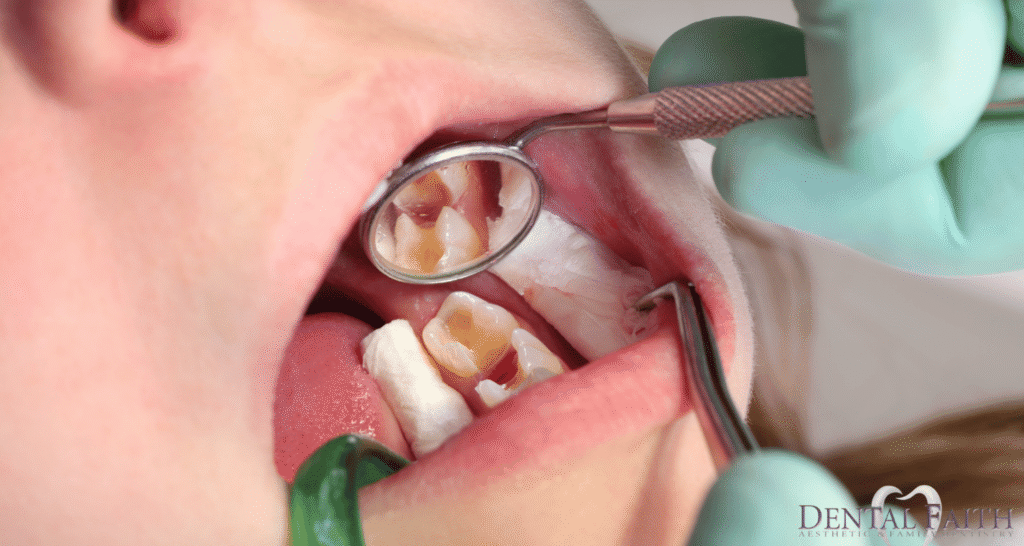How to Heal Dental Cavities
Tooth decay is the most frequent dental problem among the population, regardless of age. Nevertheless, many people underestimate how easily this process can develop if it is overlooked. Not only do cavities diminish the appearance of your smile, but they can also cause pain and sensitivity. It can also cause infections that interfere with day-to-day life.
The path to healthier teeth is not about quick solutions, but rather about familiarizing ourselves with the symptoms and warning factors. Aside from this, you must also know the oral regimens that can halt or reverse the effects of decay at a young age. At Dental Faith, we believe that protecting your teeth extends beyond the chair, empowering individuals with information, procedures, and dependable practices that work to maintain long-term dental health.
Symptoms That Signal the Start of Cavities
Tooth cavities do not develop overnight. Some of the early symptoms may be mild and do not receive attention until the ailment progresses. Hot or cold beverage intolerance, sharp pain when biting food, discoloration of the enamel, or pale white stains are indicators that the protective outer coating of the tooth is becoming weaker.
As decay advances, the discomfort can change to more prolonged toothaches, cavities that can be seen on the teeth, and even puffiness on the surrounding gums. Early identification of these symptoms provides an opportunity for intervention before higher levels of treatment are required.

Causes Behind Tooth Decay
Tooth decay does not have a single cause. It can be caused by a combination of factors involving habits and food types that affect the activity of the bacteria in the mouth. The most widespread cause is the buildup of plaque, resulting from bacteria on food particles producing acids that disintegrate the enamel.
Consuming a lot of snacks during the day on products rich in sugar or starch. Neglecting to brush or floss also increases the risk of reduced saliva production. On the one hand, genetics predisposes some people. Lifestyle also plays a much more significant role. The good news is that nearly all of them can be prevented by following proper oral care practices and minor changes that accrue over the long run.
The Role of Cavity Protection in Daily Life
It is always better to protect than to correct. The most solid defense against the decay is simple, yet regular measures. Brushing twice daily with fluoride helps to fight tooth decay by strengthening the enamel and restoring minerals to areas of tooth enamel that are vulnerable to decay.
Daily flossing helps prevent dentistry decay by penetrating spaces where a toothbrush cannot reach and removing the plaque that forms between teeth. Rinsing with water after meals will allow the removal of the remnants of acids.
Even sugar-free chewing gum can be helpful because saliva glands are activated during chewing, neutralising acids and providing natural repair. When such practices are incorporated into daily life, the resilience that eliminates the occurrence of tooth decay becomes a key factor in avoiding the onset of a more intense disease.
Can You Reverse Cavities Naturally?
A lot of controversy surrounds whether cavities are reversible. Although non-professionals cannot reverse the progression of advanced decay, specific practices, such as oil pulling, may be effective in the initial phases on some occasions.
White areas that are visible even before a cavity develops can be remineralized with regular application of fluoride and minerals as found in toothpaste, mouthwashes to prevent cavities, and food. Alternative therapies used to treat cavities usually involve remineralization through the consumption of nutritious foods, vitamin D, and calcium.
Oils, including coconut oil, have been employed in practices such as oil pulling, which are believed to reduce the number of bacteria. However, they should not be considered as a substitute for proven treatments. Natural teeth-cleaning techniques can be helpful, but they only work with evidence-based oral health maintenance and professional examinations.
Modern Dental Treatments for Cavities
When the decay reaches more advanced stages, treatment should be given to restore health. Depending on the conditions, the dentist can suggest fillings to replace the decayed area of the tooth, crowns to cover larger portions of damage, or root canal treatment in case the inner pulp is infected.
The use of dental sealants also comes in as an effective preventive measure, particularly for children, as they seal off the surface of the molars where food mainly builds up. These therapies mend the structure in addition to preventing the spread of bacteria. Modern dental technology has ensured that current treatments are more comfortable, quicker, and less invasive than in the past.
Preventing Tooth Decay Before It Starts
Oral health depends primarily on prevention. Developing a daily pattern will form the best shield. Cavity protection can be achieved every day by brushing twice with fluoride toothpaste, flossing at least once a day, and going to the dentist.
The reduction of sugary snacks, their substitution with high-nutrient foods, and the consumption of increased amounts of water during the day create conditions that are not conducive to decay.
Chewing sugar-free gum promotes the natural defense of teeth since saliva constitutes part of the body’s defense mechanism. To ensure healthier smiles throughout their lifetime, parents should play a key role in instilling the habit in children at an early age.

Natural Remedies That Support Dental Health
There is no natural way to substitute for professional care; some approaches, however, are complementary. The antioxidants in green tea are capable of lessening the effects of harmful bacteria. The food we consume balances the mineral health in teeth due to:
- Phosphorus
- Magnesium
- Vitamin K2
Coconut or sesame oil pulling has the potential to temporarily reduce the number of bacteria. A natural alternative sweetener, Xylitol, found in sugar-free gum helps prevent cavities by targeting bacteria that cause them. Along with brushing, flossing, and professional care, these at-home, natural solutions to cavities are most likely to work as part of a larger oral care strategy, not in place of such care efforts.
Lifestyle Changes That Aid Healing
Other than brushing and flossing, a general lifestyle choice has an impact on the risk of having a cavity. Smoking causes a decrease in saliva and a weakened immune system, causing decay to be more aggressive. Teeth grinding caused by stress is also one of the causes of the wearing down of enamel.
Eating well and being hydrated help maintain a healthy oral environment. Care at night is essential because during sleep, dental fluid is reduced, thus leaving bacteria with more time to operate. Tiny and frequent alterations, on top of being maintained, offer long-acting protection that lessens the dependency on more intrusive measures.
Moving Toward a Healthier Smile
Curing tooth decay is not a matter of a patch job but establishing the strength through everyday disciplines, preventive medication, and consciousness of the symptoms before their maturation. Fluoride toothpaste can work wonders, as can dental sealants when necessary, sugar-free gum to look after the teeth, and even natural remedies in some instances. Most cavities are preventable, and in most cases, modern treatment cures the teeth. Our goal at Dental Faith is to provide each person with the proper tools, education, and motivation to keep the smile they have forever.
FAQs
Can dental cavities heal naturally?
Cavities in their preliminary stages can be remineralized using fluoride solution, saliva, and proper teeth care. However, once the decay reaches the inner part of the teeth, the earliest lesions, known as the white spot, can only be recovered through treatment.
Can a cavity recover on its own?
Once enamel is damaged, there is no way that a cavity can be repaired. The white spot may still be reversed through the use of fluoride and good practice before a hole forms.
How to reverse cavities in kids?
Cavities at a very early age can be prevented and even reversed when fluoride toothpaste and dental sealants are used alongside a nutritious diet, allowing repair of children’s tooth enamel.
When is it too late to heal a cavity?
It becomes too late once the state of decay reaches dentin or the pulp, when the condition will result in pain or evident holes, and this is when professional help is needed in the form of filling or crowns.
